radiator CHEVROLET CAVALIER 1996 3.G Owners Manual
[x] Cancel search | Manufacturer: CHEVROLET, Model Year: 1996, Model line: CAVALIER, Model: CHEVROLET CAVALIER 1996 3.GPages: 372, PDF Size: 19.73 MB
Page 220 of 372
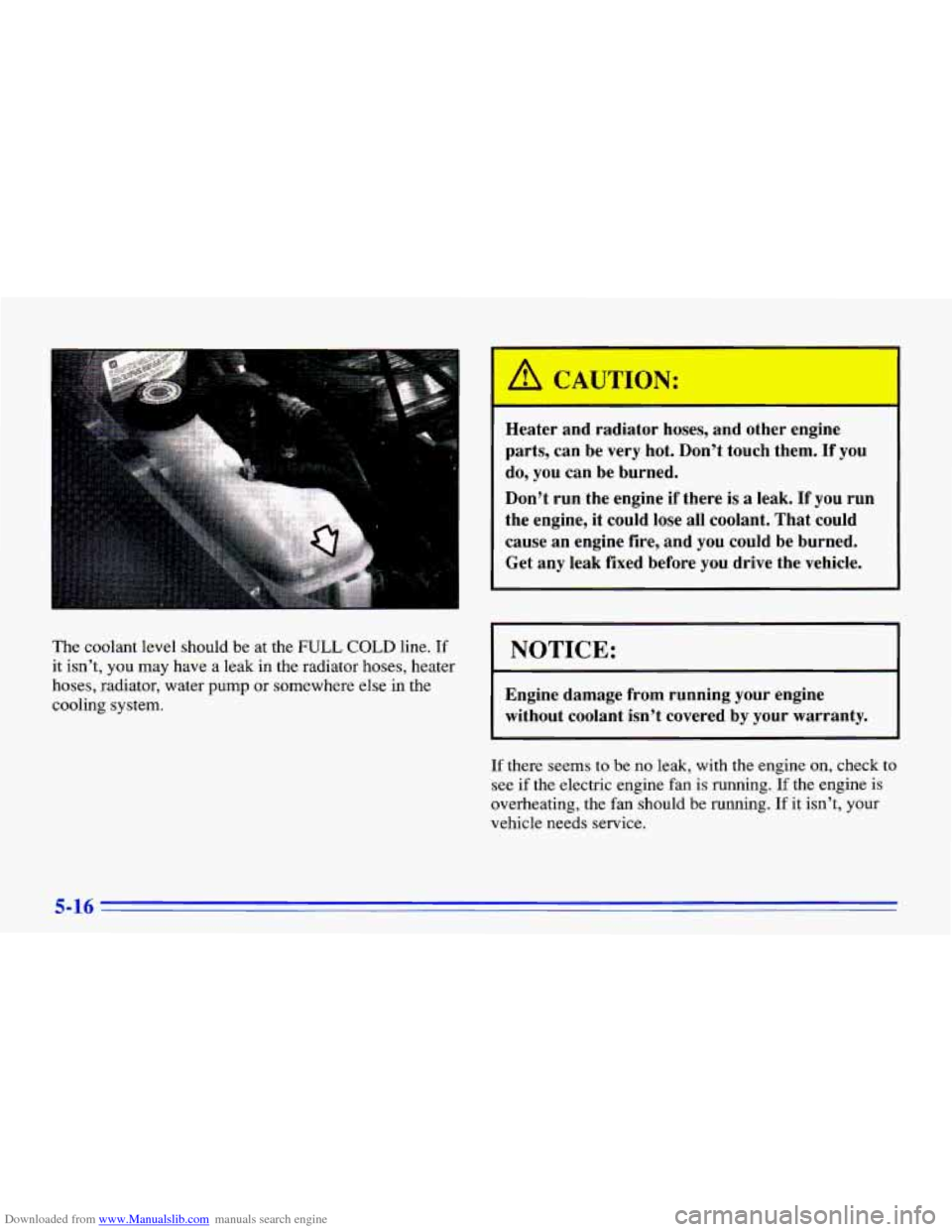
Downloaded from www.Manualslib.com manuals search engine The coolant level should be at the FULL COLD line. If
it isn’t, you may have a leak in the radiator hoses, heater
hoses, radiator, water pump
or somewhere else in the
cooling system.
’ A C * UTION:
-- I
Heater and radiator hoses, and other engine
parts, can be very hot. Don’t touch them. If you
do, you can be burned.
Don’t run the engine
if there is a leak. If you run
the engine, it could lose all coolant. That could
cause an engine fire, and you could be burned.
Get any leak fixed before you drive the vehicle.
I NOTICE:
r
~~ ~
Engine damage from running your engine
without coolant isn’t covered by your warranty.
If there seems to be no leak, with the engine on, check to
see if the electric engine fan is running.
If the engine is
overheating, the fan should be running. If it isn’t, your
vehicle needs service.
Page 222 of 372
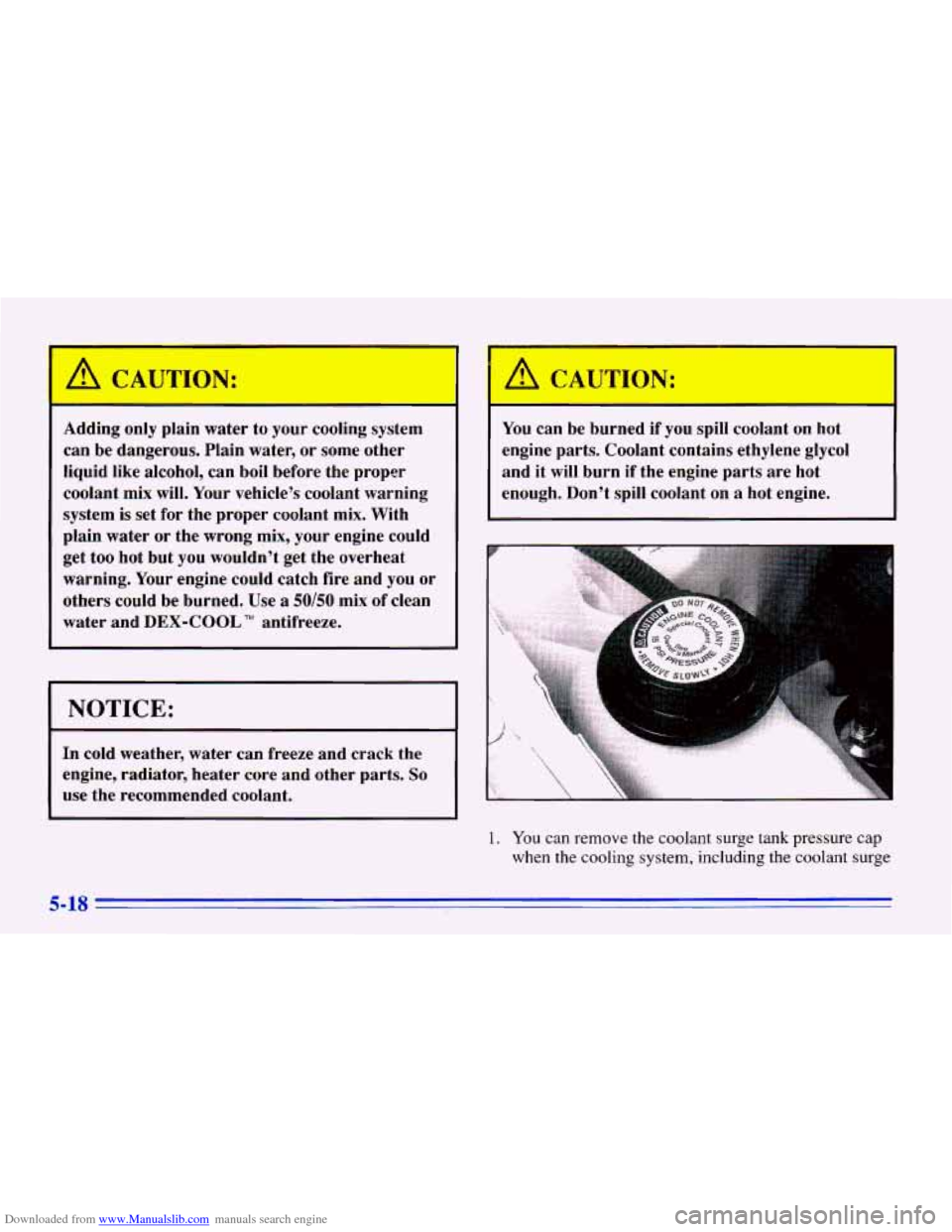
Downloaded from www.Manualslib.com manuals search engine A CAUTION:
Adding only plain water to your cooling system
can be dangerous. Plain water,
or some other
liquid like alcohol, can boil before the proper
coolant mix will. Your vehicle's coolant warning
system is set
for the proper coolant mix. With
plain water or the wrong mix, your engine could
get
too hot but you wouldn't get the overheat
warning. Your engine could catch
fire and you or
others could be burned.
Use a 50/50 mix of clean
water and
DEX-COOL TM antifreeze.
I NOTICE:
In cold weather, water can freeze and crack the
engine, radiator, heater core and other parts.
So
use the recommended coolant. You
can be burned if you spill coolant
01 lot
engine parts. Coolant contains ethylene glycol
and it will burn if the engine parts are hot
enough. Don't spill coolant on
a hot engine.
1. You can remove the coolant surge tank pressure cap
when the cooling system, including the
coolant surge
5-18
Page 223 of 372
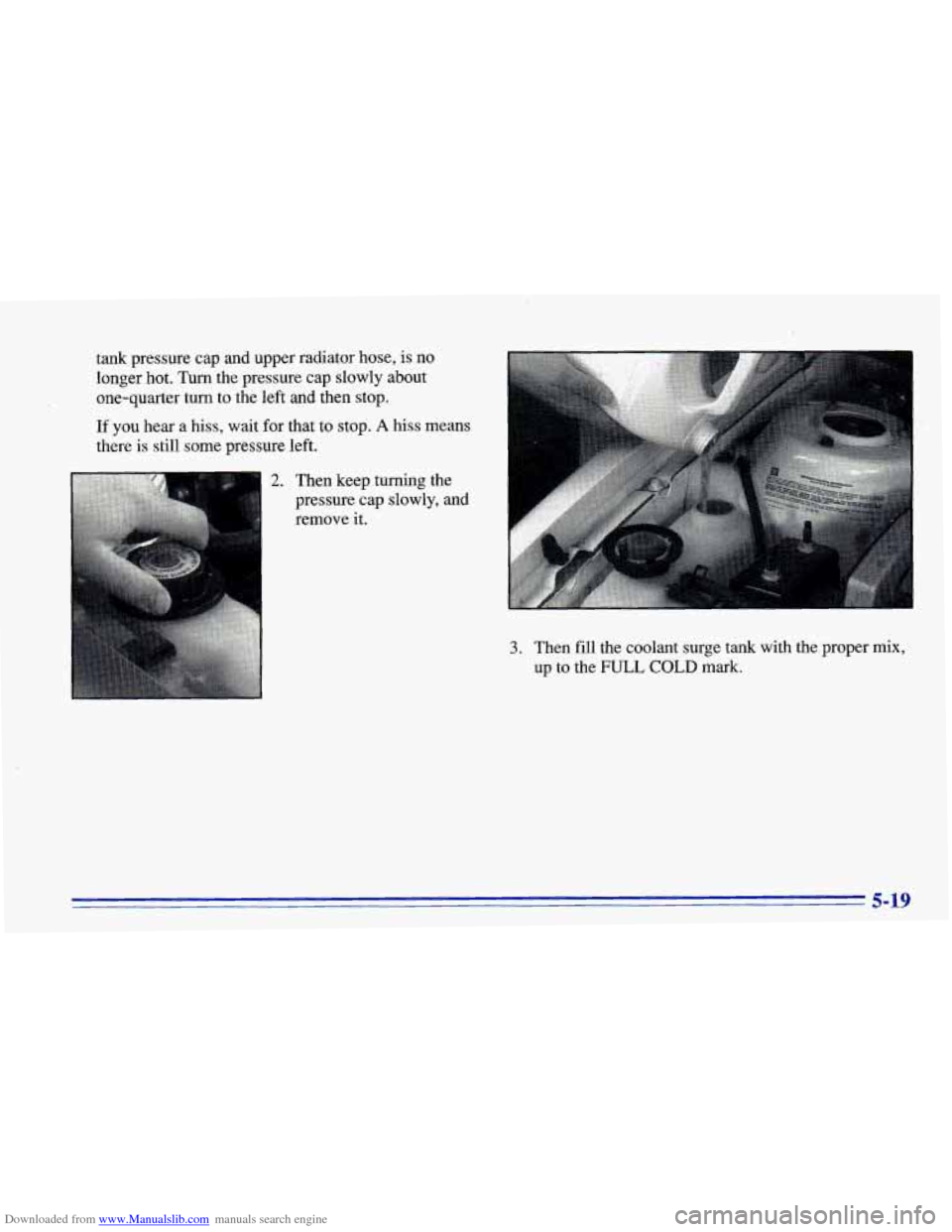
Downloaded from www.Manualslib.com manuals search engine tank pressure cap and upper radiator hose, is no
longer hot. Turn the pressure cap slowly about
one-quarter turn to the left and then stop.
that to stop.
A hiss means
left. If you hear a hiss, wait for
there
is still some pressure
2. Then keep turning the
pressure cap slowly, and
remove it.
3. Then fill the coolant surge tank with the proper mix,
up to the
FULL COLD mark.
5-19
Page 224 of 372
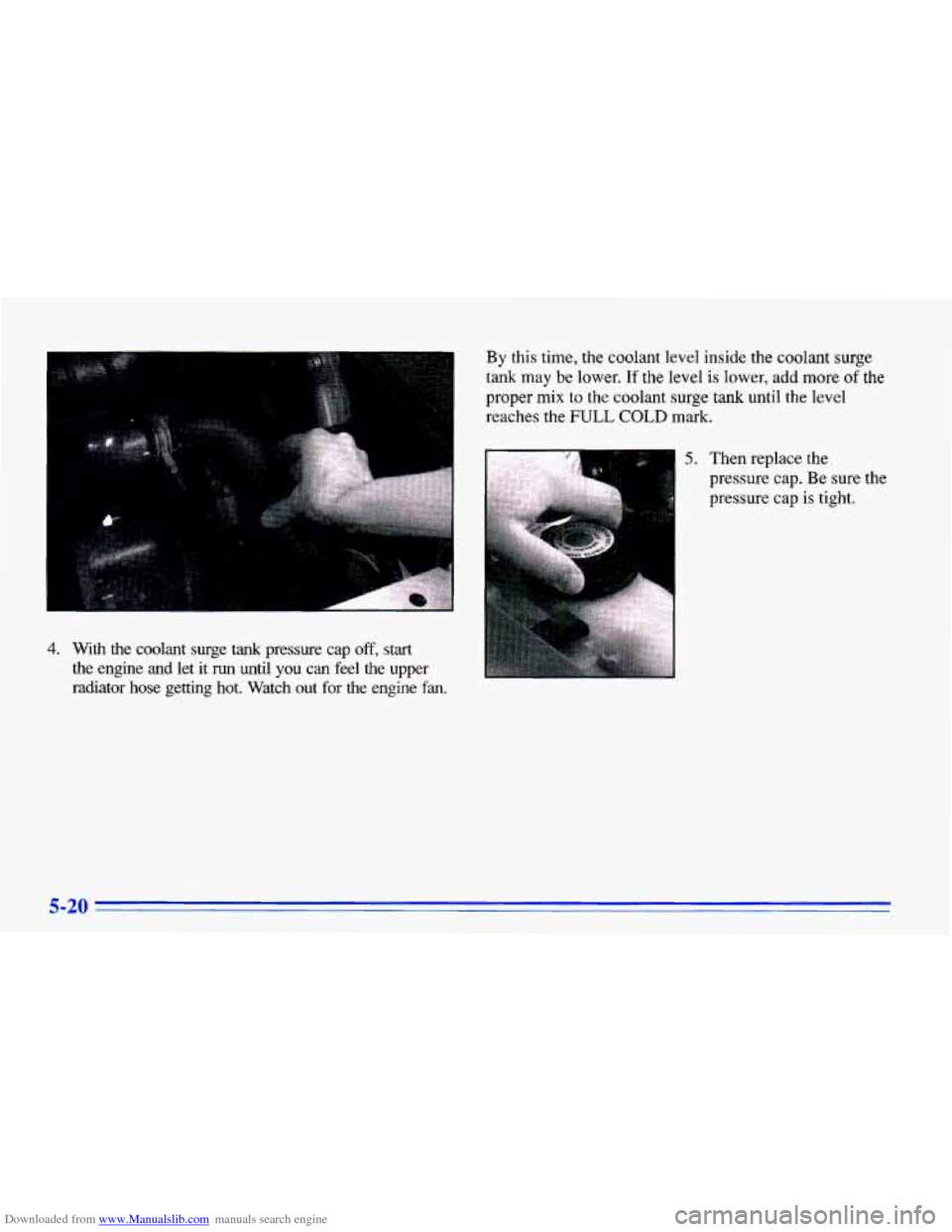
Downloaded from www.Manualslib.com manuals search engine I
4.
I
With the coolant surge tank pressure cap off, start
the engine and let it run until you can feel the upper
radiator hose getting hot. Watch out for the engine fan.
By this time, the coolant level inside the coolant surge
tank may be lower. If the level is lower, add more of the
proper mix
to the coolant surge tank until the level
reaches the
FULL COLD mark.
5. Then replace the
pressure cap. Be sure the
pressure cap is tight.
5-20
Page 261 of 372
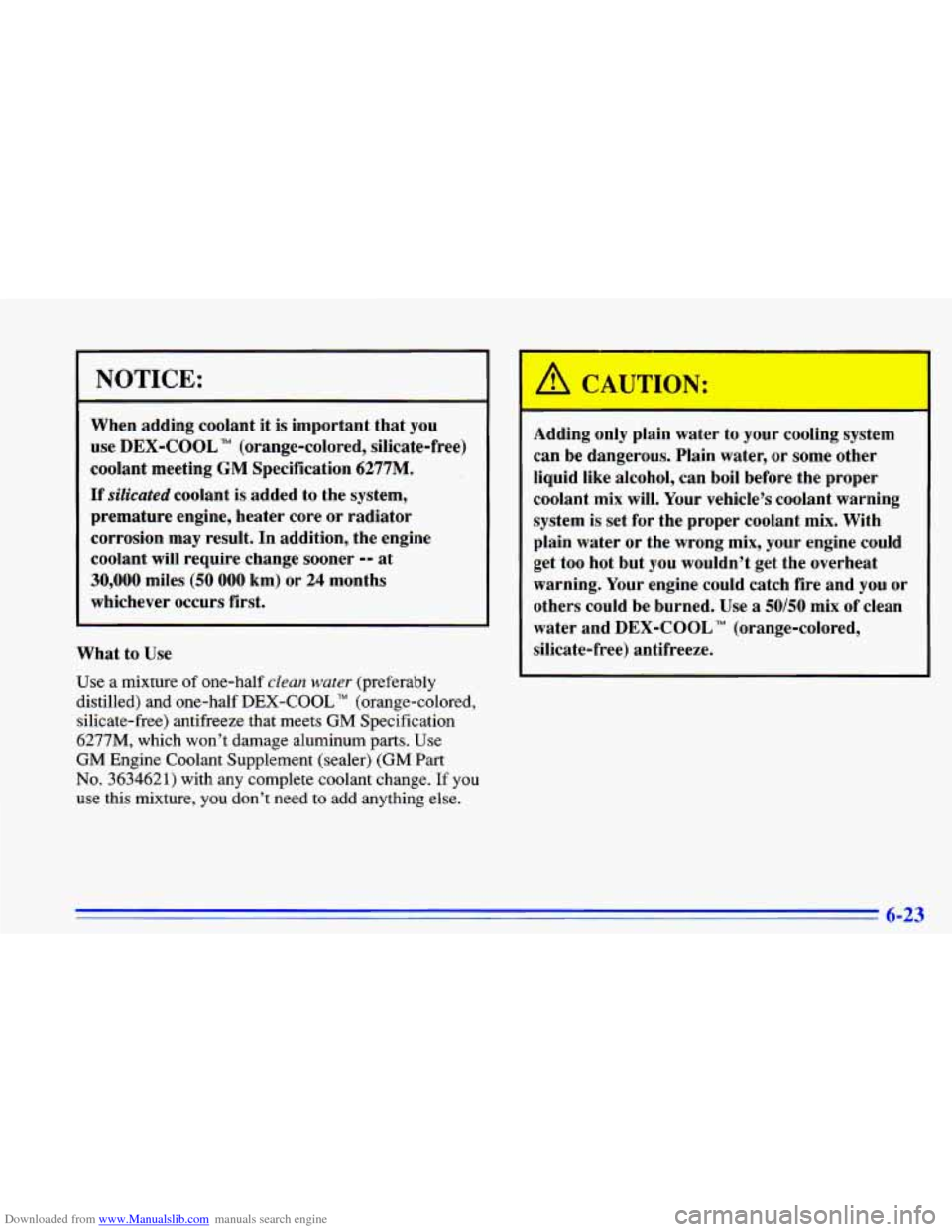
Downloaded from www.Manualslib.com manuals search engine NOTICE:
When adding coolant it is important that you
use DEX-COOL
TM (orange-colored, silicate-free)
coolant meeting
GM Specification 6277M.
If silicated coolant is added to the system,
premature engine, heater core or radiator
corrosion may result. In addition, the engine
coolant will require change sooner
-- at
30,000 miles (50 000 km) or 24 months
whichever occurs first.
What to Use
Use a mixture of one-half clean water (preferably
distilled) and one-half
DEX-COOL TM (orange-colored,
silicate-free) antifreeze that meets
GM Specification
6277M, which won’t damage aluminum parts. Use
GM Engine Coolant Supplement (sealer) (GM Part
No. 3634621) with any complete coolant change. If you
use this mixture, you don’t need to add anything else.
Adding only plain water to your cooling system
can be dangerous. Plain water, or
some other
liquid like alcohol, can boil before the proper
coolant mix will. Your vehicle’s coolant warning
system is set
for the proper coolant mix. With
plain water
or the wrong mix, your engine could
get too hot but you wouldn’t get the overheat
warning. Your engine could catch fire and you
or
others could be burned. Use a 50/50 mix of clean
water and DEX-COOL
TM (orange-colored,
silicate-free) antifreeze.
6-23
Page 262 of 372
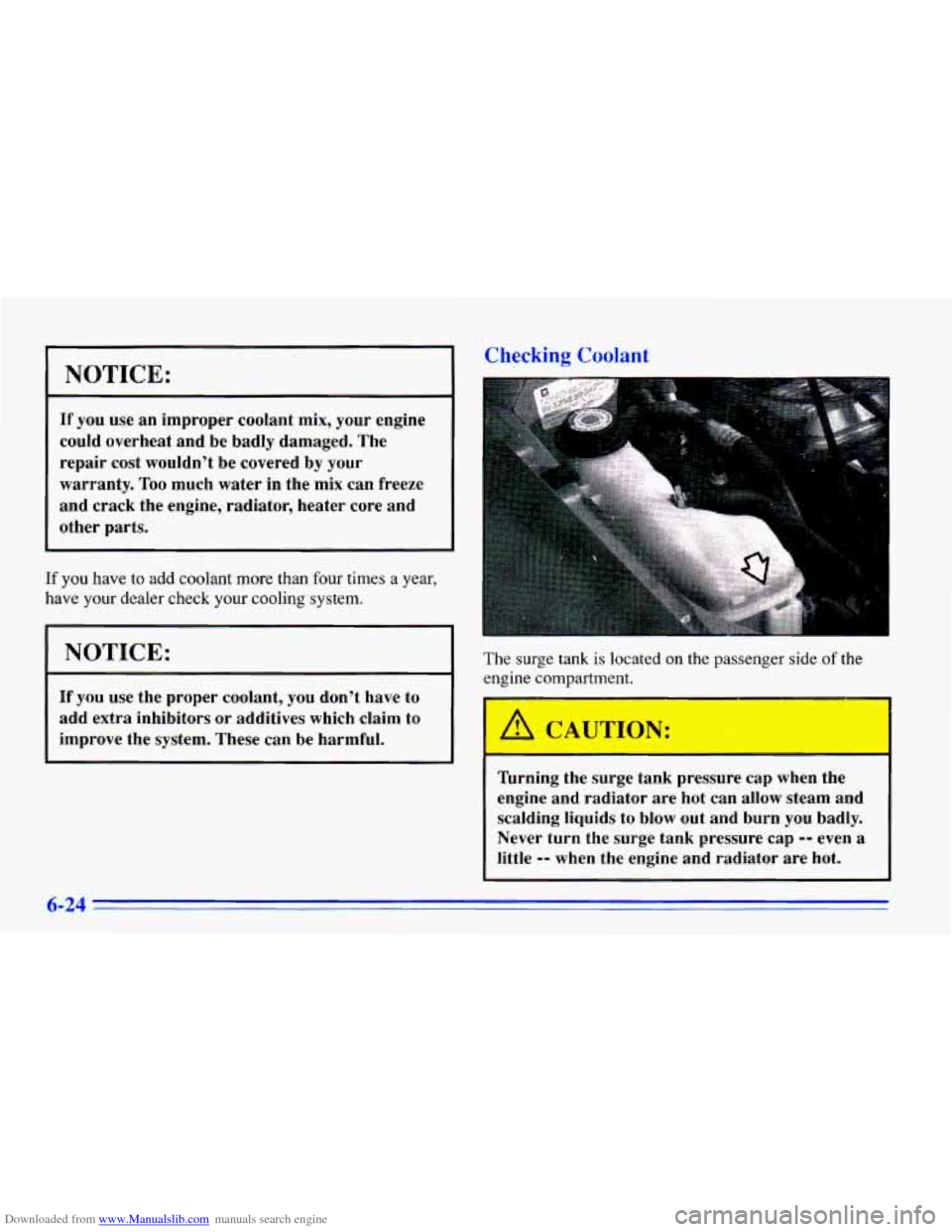
Downloaded from www.Manualslib.com manuals search engine NOTICE:
If you use an improper coolant mix, your engine
could overheat and be badly damaged. The
repair cost wouldn't
be covered by your
warranty.
Too much water in the mix can freeze
and crack the engine, radiator, heater core and
other parts.
If you have to add coolant more than four times a year,
have your dealer check your cooling system.
NOTICE:
If you use the proper coolant, you don't have to
add extra inhibitors or additives which claim to
improve the system. These can be harmful.
I
Checking Coolant
The surge tank is located on the passenger side of the
engine compartment.
"urning the surge tank pressure cap when the
engine and radiator are hot can allow steam and
scalding liquids to blow out and burn you badly.
Never turn the surge tank pressure cap
-- even a
little -- when the engine and radiator are hot.
6-24
Page 264 of 372
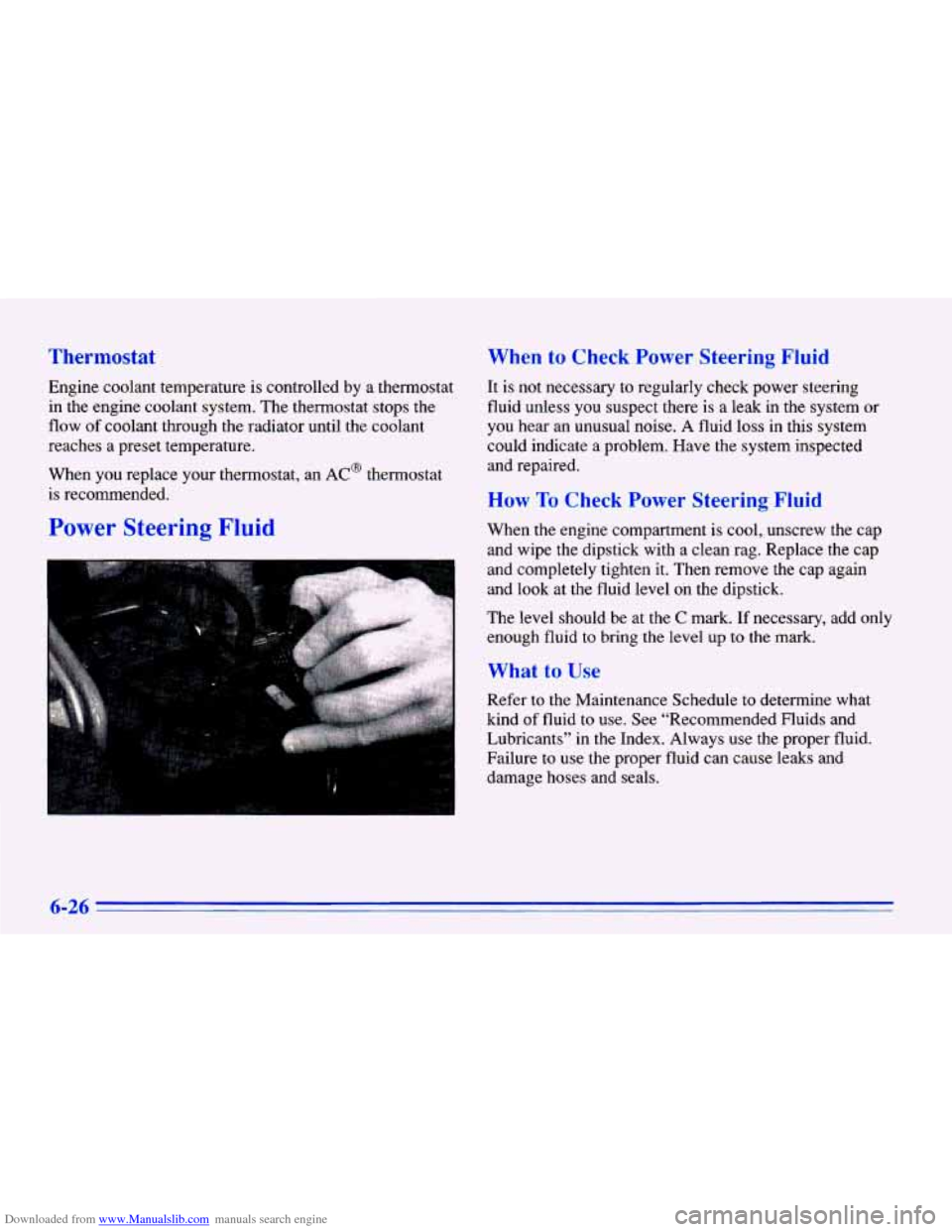
Downloaded from www.Manualslib.com manuals search engine Thermostat
Engine coolant temperature is controlled by a thermostat
in the engine coolant system. The thermostat stops the
flow of coolant through the radiator until the coolant
reaches
a preset temperature.
When you replace your thermostat, an
AC’ thermostat
is recommended.
Power Steering Fluid
When to Check Power Steering Fluid
It is not necessary to regularly check power steering
fluid unless you suspect there
is a leak in the system or
you hear an unusual noise.
A fluid loss in this system
could indicate a problem. Have the system inspected
and repaired.
How To Check Power Steering Fluid
When the engine compartment is cool, unscrew the cap
and wipe the dipstick with a clean rag. Replace the cap
and completely tighten it. Then remove the cap again
and look at the fluid level on the dipstick.
The level should be at the
C mark. If necessary, add only
enough fluid
to bring the level up to the mark.
What to Use
Refer to the Maintenance Schedule to determine what
kind
of fluid to use. See “Recommended Fluids and
Lubricants” in the Index. Always use the proper fluid.
Failure
to use the proper fluid can cause leaks and
damage hoses and seals.
6-26
Page 265 of 372
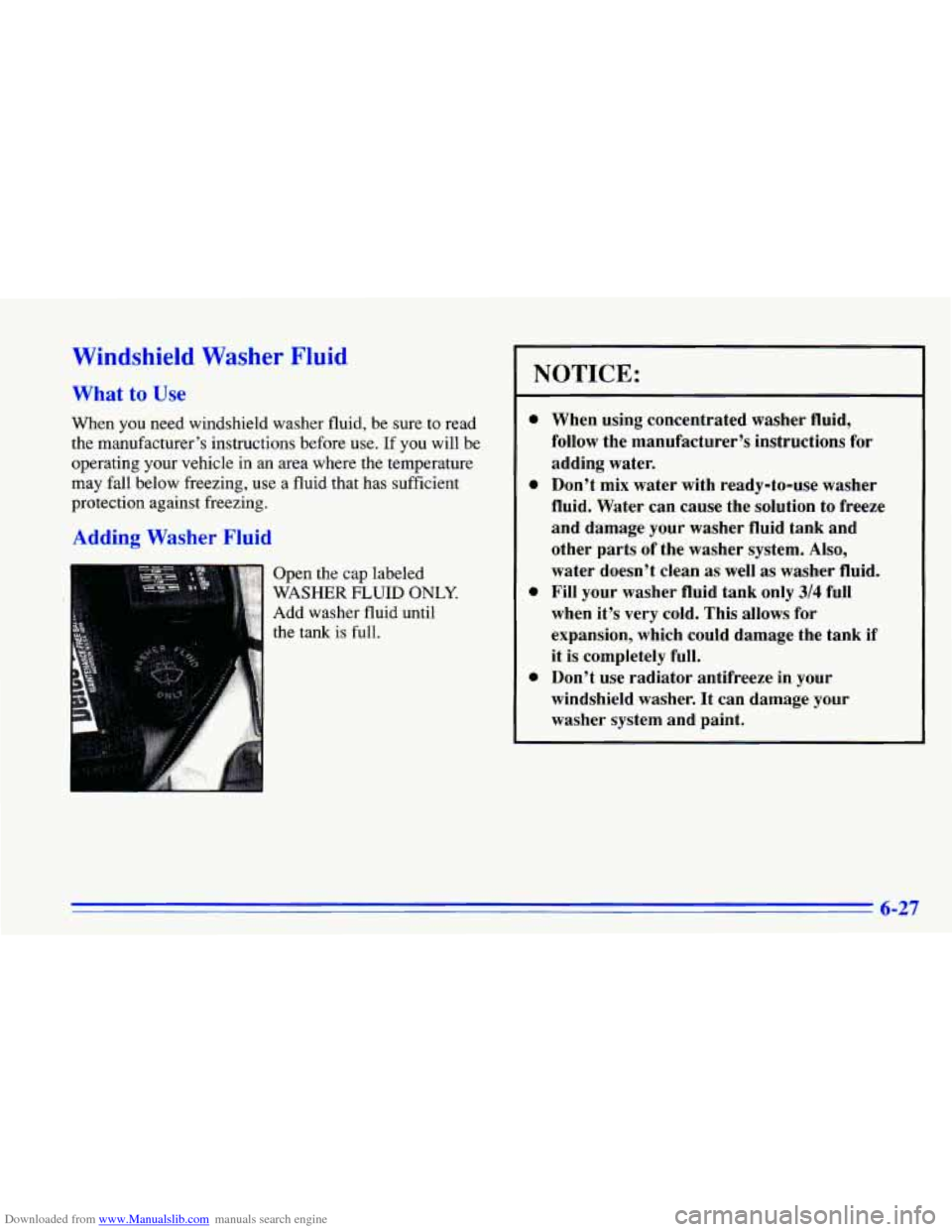
Downloaded from www.Manualslib.com manuals search engine Windshield Washer Fluid
What to Use
When you need windshield washer fluid, be sure to read
the manufacturer’s instructions before use. If you will be
operating your vehicle
in an area where the temperature
may fall below freezing, use
a fluid that has sufficient
protection against freezing.
Adding Washer Fluid
Open the cap labeled
Add washer fluid until
the tank is
full.
WASHER FLUID ONLY.
NOTICE:
0
0
0
0
When using concentrated washer fluid,
follow the manufacturer’s instructions for
adding water.
Don’t mix water with ready-to-use washer
fluid. Water can cause the solution to freeze
and damage your washer fluid tank and
other parts of the washer system. Also,
water doesn’t clean
as well as washer fluid.
Fill your washer fluid tank only
3/4 full
when
it’s very cold. This allows for
expansion, which could damage the tank if
it
is completely full.
Don’t use radiator antifreeze in your
windshield washer.
It can damage your
washer system and paint.
6-27
Page 323 of 372
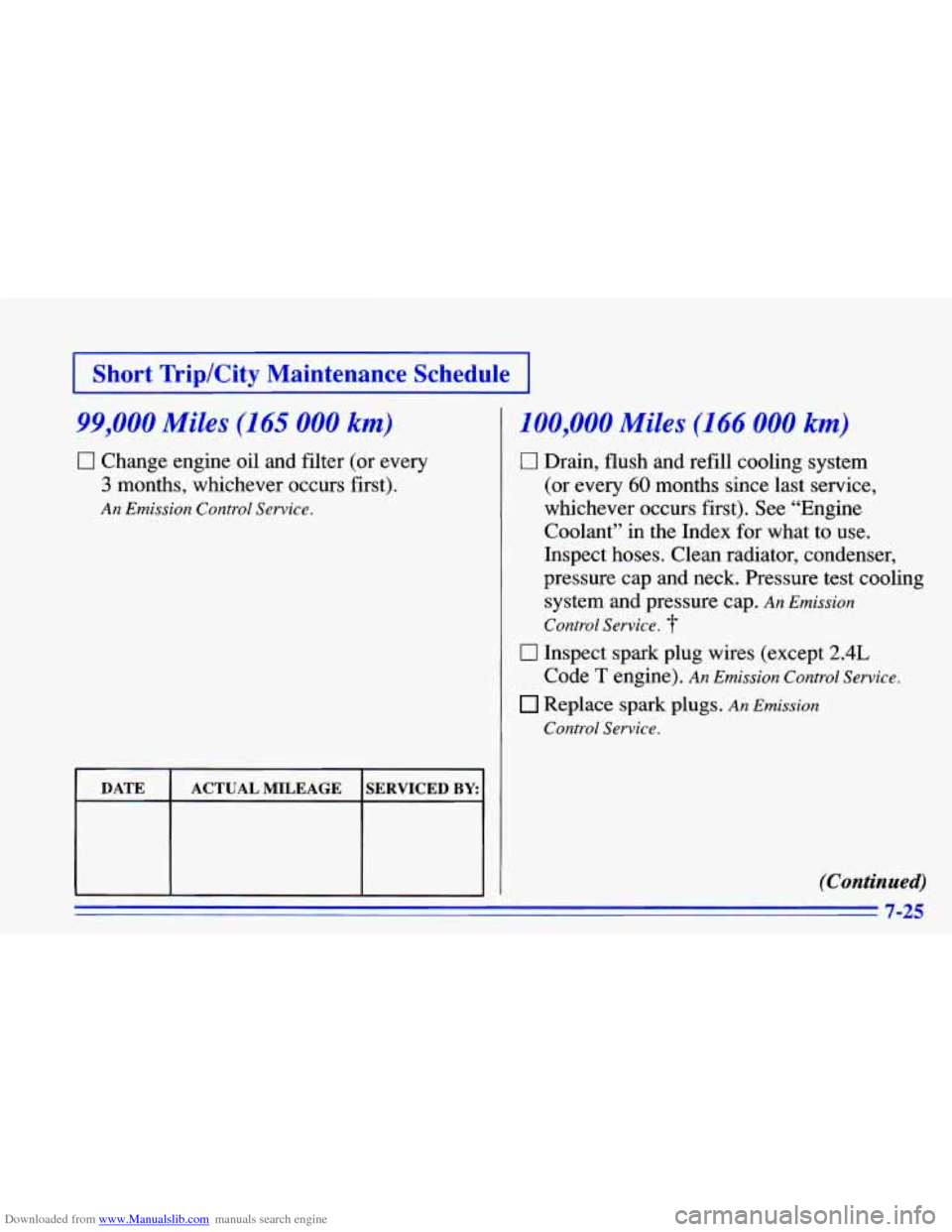
Downloaded from www.Manualslib.com manuals search engine I Short Trip/City Maintenance Schedule I
99,000 Miles (165 000 km)
0 Change engine oil and filter (or every
3 months, whichever occurs first).
An Emission Control Service.
I DATE ACTUAL MILEAGE SERVICED BY: I
I
100,000 Miles (166 000 km)
0 Drain, flush
and refill cooling system
(or every
60 months since last service,
whichever occurs first). See “Engine
Coolant”
in the Index for what to use.
Inspect hoses. Clean radiator, condenser,
pressure cap and neck. Pressure test cooling
system and pressure cap.
An Emission
Control Service.
0 Inspect spark plug wires (except 2.4L
Replace spark plugs. An Emission
Code T engine). An Emission Control Service.
Control Service.
(Continued)
7-25
Page 334 of 372
![CHEVROLET CAVALIER 1996 3.G Owners Manual Downloaded from www.Manualslib.com manuals search engine I Long Trip/Highway Maintenance Schedule
97,500 Miles (162 500 km)
c] Change engine oil and filter (or every
12 months, whichever occ CHEVROLET CAVALIER 1996 3.G Owners Manual Downloaded from www.Manualslib.com manuals search engine I Long Trip/Highway Maintenance Schedule
97,500 Miles (162 500 km)
c] Change engine oil and filter (or every
12 months, whichever occ](/img/24/8080/w960_8080-333.png)
Downloaded from www.Manualslib.com manuals search engine I Long Trip/Highway Maintenance Schedule
97,500 Miles (162 500 km)
c] Change engine oil and filter (or every
12 months, whichever occurs first).
An Emission Control Service.
Lubricate the suspension, steering linkage
and the transaxle shift linkage (or every
12 months, whichever occurs first).
0 Rotate tires. See “Tire Inspection and Rotation” in the Index for proper rotation
pattern and additional information. During tire rotation, check brake calipers for freedom of movement. Refer to the
appropriate
GM service manual for proper
caliper service procedures.
100,000 Miles (166 000 km)
Drain, flush and refill cooling system
(or every
60 months since last service,
whichever occurs first). See “Engine
Coolant”
in the Index for what to use.
Inspect hoses. Clean radiator, condenser,
pressure cap
and neck. Pressure test the
cooling system and pressure cap.
An Emission
Control
Service.
Inspect spark plug wires (except 2.4L
Replace spark plugs. An Emission
Code T engine). An Emission Control Service.
Control Service.